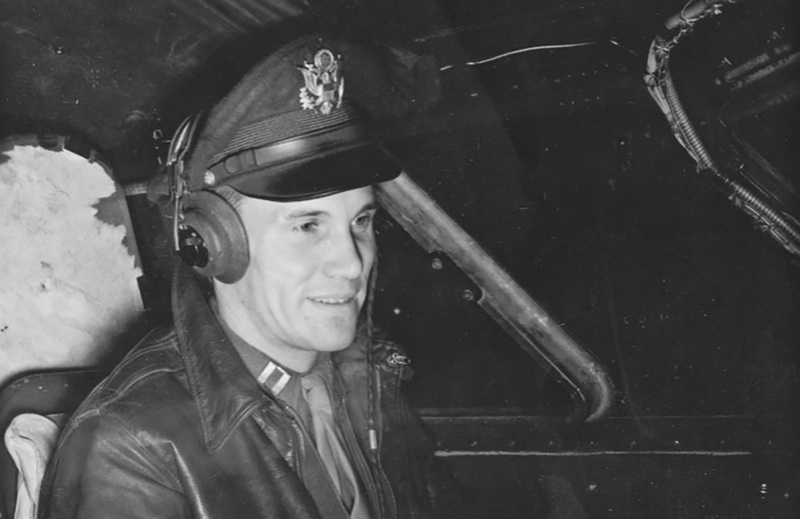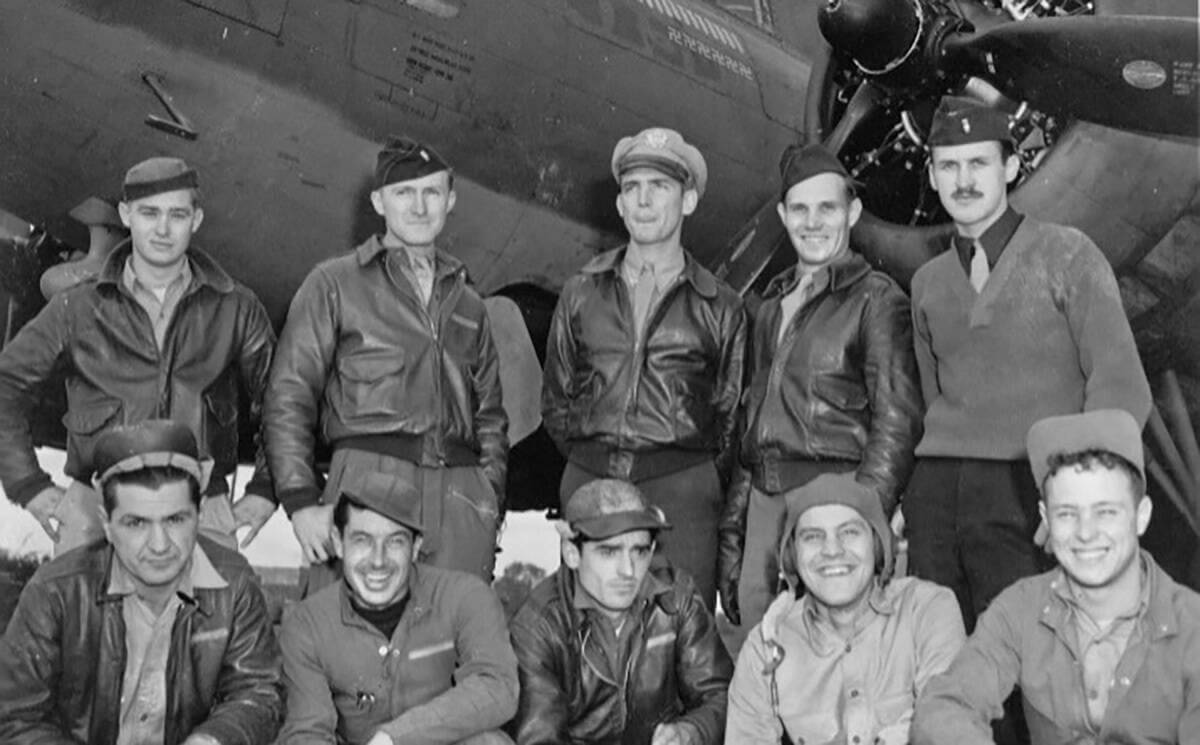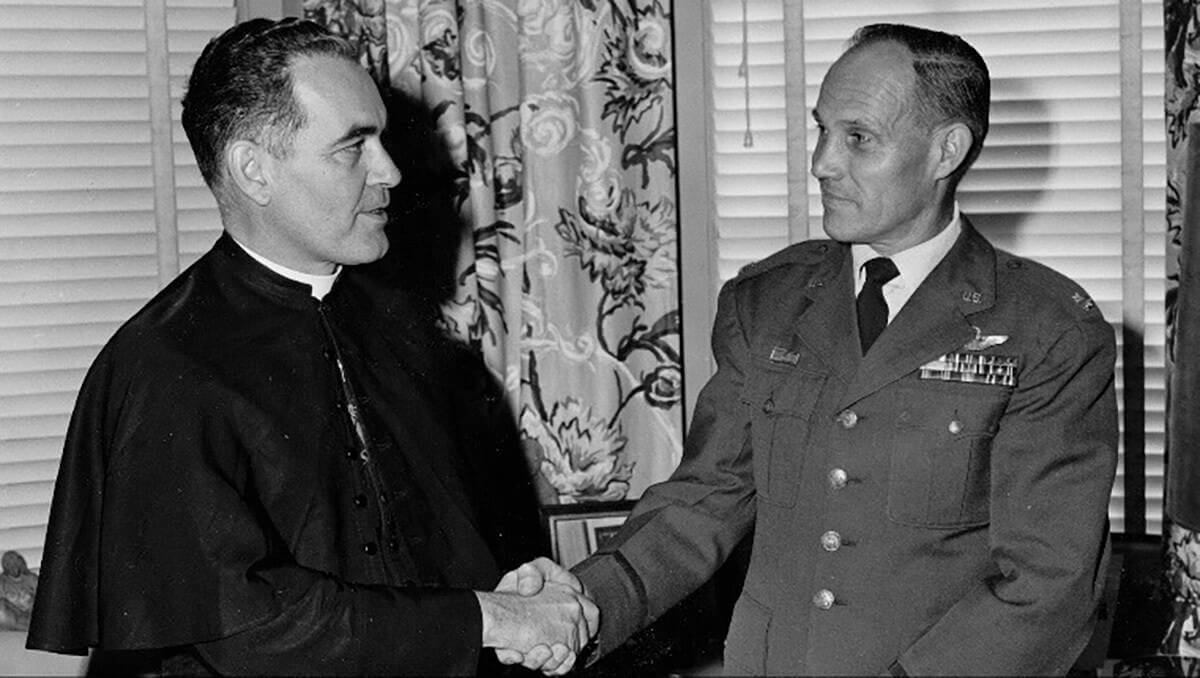 “A natural-born leader and all business in the air,” according to his navigator, Blakely believed in “practice, practice, practice” to prepare for combat missions. Photos courtesy of Jim Blakely ’69
“A natural-born leader and all business in the air,” according to his navigator, Blakely believed in “practice, practice, practice” to prepare for combat missions. Photos courtesy of Jim Blakely ’69
On several of World War II’s most dangerous missions, Lt. Col. Everett Blakely ’64M.A., was a B-17 pilot, leading bombing missions deep into Germany and bringing his men safely home, sometimes in severely crippled aircraft.
“Were it not for Ev Blakely, I would not be here. He was a natural-born leader and all business in the air,” his navigator, Harry Crosby, wrote in his book, A Wing and a Prayer, one of the many volumes that documents Blakely’s aerial exploits during the war.
He was part of the 100th Bomb Group, known as “The Bloody 100th” for the disproportionate casualties it suffered. The new Steven Spielberg and Tom Hanks-produced miniseries, Masters of the Air, premiering January 26 on Apple TV, dramatizes the group’s experience. Actor David Shields portrays Blakely.
Blakely and his brother, Bob, grew up in Seattle, where their father was chief bellman at the city’s best hotel. Their mother died in a freak train accident when Everett was six years old. Years later he described his family as “not rich and not what you’d call poor,” and summed up his childhood and adolescence in two words: hard work.
Morning and afternoon paper routes, selling magazines in the evenings, and summers picking blueberries occupied the Blakely boys. “So, I’d be up before light to deliver the papers, and then I’d come home, pick the berries and when the afternoon papers arrived, I delivered them — and I’d go out after dinner trying to sell the blackberries,” Everett Blakely told his son, Jim ’69, in a 1989 video interview that serves as the basis of this story. “I remember being out late at night — knowing I’d have to get up at 2 or 3 in the morning again.”
Living at home while attending the University of Washington, Blakely recalled, the specter of war inspired him to enlist in summer 1941, several months before Pearl Harbor.
“We’re going to get into this war and the Air Force is coming around recruiting for pilots, so I’m going down and sign up,’” Blakely recalled telling his father. “Dad didn’t argue; he said, ‘I think your judgment is right.’”

According to a friend, Blakely’s interest in flying may trace back to the day he was selling newspapers in the Seattle airport and “Amelia Earhart flew in a bought him a Coke.”
He trained in California on fighter aircraft — the P-36, P-40, P-43 — but after a transfer to McDill Air Force Base in Florida, “our orders changed” to B-17s. “I thought, those are bombers, we’re fighter pilots.”
Domestic training missions preceded combat in Europe, including a month in Sioux City, Iowa, where Blakely met “the first girl I ever seriously kissed.” Her name was Margaret Ann Spence. “When I met her, everything went bling! That was the end of it.”
Inclement winter weather kept planes grounded and allowed the new couple a chance to get acquainted. “Our courtship was long; it took me seven days to propose.” They were married three months later at an Idaho air base, not long before Blakely would be deployed for the duration of the war to Thorpe Abbots USAAF Station 139 in England.
“Every morning or afternoon when we were not flying a mission, Ev checked out a plane and rounded up the crew,” Crosby wrote in A Wing and a Prayer. “Weather permitting, we went up to 25,000 feet and practiced. Practice, practice, practice. I don’t know when I finally began to like Ev Blakely, but I do know that I respected him almost immediately. I give him a lot of credit for my later success as a navigator.”
Blakely’s crew embarked on numerous dangerous raids during the war. “There are two missions,” he told his son, “that loom large in my memory.”
The first, on August 17, 1943, involved a strike on the Messerschmitt factory in Regensburg, deep in southern Germany.
“A lot of leaders believed: if you had the right force, you could go deep into the heartland and bomb Germany without a fighter escort and strike a devastating blow — and then hop over the Alps and land in Africa,” Blakely said. “This mission would be a big test of that belief.”
Coordination with another division and inclement weather complicated the planning and timing. “When we went in, our group was last and low; I was leading it and we got hit pretty damn hard,” Blakely said. “We had 21 birds going in — we had 12 when we got to Africa — and only six were flyable all the way back to England. Something like 60 aircraft all together were lost on that one mission. It doesn’t take much math to know we had gotten clobbered.”
Blakely’s plane — and the men on his crew — returned intact. “Fortunately,” he said. “I had no wounded and no significant damage.”

Less than two months later, on October 8, 1943, Blakely flew the lead plane, nicknamed Just-a-Snappin’, on a mission to the submarine pens in Bremen, Germany. War reporter Bob Considine described the scene in an article a week later: “Hell came up and hit the lead fortress just a few seconds after it dumped its bomb load on Bremen. A heavy antiaircraft shell exploded under the number one engine, almost knocking it out of its mountings. Blakely could not feather the propeller which ruptured the burning engine.”
Blakely’s crew estimated that about 300 anti-aircraft guns were firing at them. “There was so much solid flak, you could almost slice it like cake. We needed about 25 seconds to have a long enough bomb run to operate our bombsight exactly. But that was risky because the Nazi gunners needed only 15 seconds to verify their sightings and let us have it.”
Under heavy fire and taking on increasing damage, Blakely twice had to put the plane in a steep dive and skid to extinguish an engine fire. Three gunners and Blakely’s co-pilot suffered serious injuries but the crew shot down a record nine Nazi fighters.
They considered ditching over water but realized their wounded would never survive — and the Luftwaffe had shot their inflatable dinghies full of holes. “OK, we go home,” Crosby recalled Blakely saying to him over the radio. “Croz, give me the shortest way back to England.”
Even on the shortest route, with the damage the Luftwaffe had inflicted on the plane, the journey would be slow and perilous. Descending to 4,000 feet and dropping, they began throwing guns, ammo, spent shells and clothes overboard to lighten their load. A smashed shortwave radio forced the operator to touch two wires together to send an SOS in hopes the signal would be received.
“There we were limping back over Germany at a crawling speed of 120 mph,” Blakely later wrote. At 100 mph, the plane would stall. “Our controls were chewed to ribbons; it took all my strength to control the ship. With the compass stuck, Crosby had to navigate by figuring where the sun should hit the Plexiglas front of the plane — and called out to correct the course every time the sun went someplace else. We were still 200 miles from home.”
The skies en route were crowded with enemy aircraft. “We had a running fight all the way home with the fighters who were up to finish us off,” Blakely said. A mechanic later counted more than eight hundred holes in the fully disabled aircraft — some as large as a basketball. They had only ten gallons of fuel left when they reached friendly shores.
“Almost as soon as we edged over England, we sighted an airport where we knew we had to crash land — and do it right the first time,” Blakely said. When they hit the ground, the broken tail wheel collapsed and the rudder control lines snapped. Just-a-Snappin’ rolled crazily across field and into a tree where it folded like an accordion.
Blakely was uninjured. The wounded were taken to the hospital. A cheer when up when the base received word that the crew, which had not been expected back, had survived. “Everybody thought we were done for,” Blakely said.
Crosby would always insist, “All that practice that Blake made us do saved our lives.”
Blakely downplayed his steely nerves that got them home: “We were lucky. Just plain lucky.”
Many were not so fortunate. In four combat missions that week alone — Bremen on October 8, Marienburg on October 9, Münster on October 10, and Schweinfurt on October 14 — the 100th Bomb Group alone lost more than 190 men and 19 planes; another 11 planes were badly damaged. The Bloody 100th nickname had never been so apt.
By the end of that week in October 1943, 13 of the 16 bunks were empty in the Quonset barracks where Blakely’s crew lived. Just-a-Snappin’s co-pilot Charley Via was in the hospital; the other 12 officers — crewmen on three other planes — had been lost and declared missing. They were prisoners who would return after the war.
After Bremen, with his own plane a scrap heap, Blakely was promoted to squadron commander, often flying as co-pilot in the lead plane and providing tactical guidance. He also served as Group Training Officer at Thorpe Abbotts airbase, where he hated being a disciplinarian. He completed his tour of 25 missions, receiving 11 medals, including the Silver Star for “gallantry in action” and the Distinguished Flying Cross for “heroism or extraordinary achievement during aerial flight.”

A reserve officer, Blakely received a regular commission after the war and decided to make the military his career. He finished college at the University of Washington and joined the Air Logistics Command with postings around the world while he and Margaret raised six children.
In 1960 Blakely came to Notre Dame, spending five years as professor of air science and head of the Air Force ROTC while earning a master’s degree in education.
Not a Catholic, he attended Mass with his wife, Margaret, but could not receive Communion. While at Notre Dame, he took classes to join the Church, unbeknownst to her. At the end of his religious instruction, “the priest asked him what he thought about the Catholic faith,” Jim Blakely says. “My dad responded, ‘I can believe about 85 percent of it.’ The priest said, ‘Well, come on in.’” The new convert surprised his wife one Sunday by receiving Communion with her.
After Notre Dame, which was his longest military assignment, Blakely and his family were sent to Europe for several postings until, after 28 years of service, “I was given a fancy boat ride on the USS United States back to the United States and when we arrived in New York harbor, I was for all intents and purposes a civilian.”
He spent 11 years as a subcontractor administrator for Lockheed Corporation. “Then I retired and went to work for my wife,” he said.
Blakely died September 21, 2004 at age 85. He was buried with full military honors.
Bob Gibbons spent 40 years as a writer for Eastman Kodak Company. He is the author of two books, Growing Up on Oriole Street, and the upcoming Becoming Aquinas. He has also co-written two volumes about the Notre Dame Class of 1969.